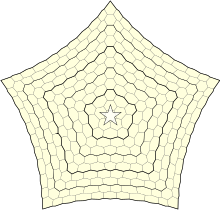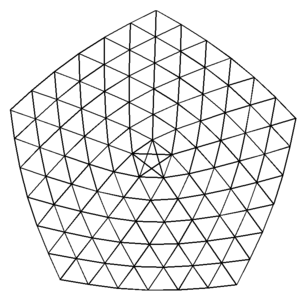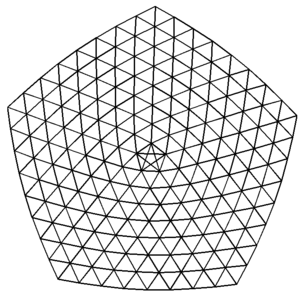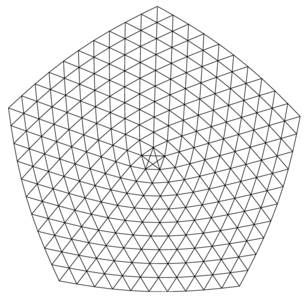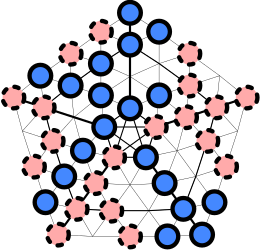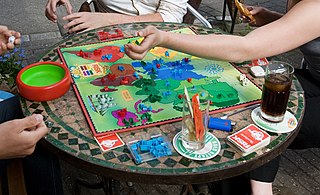
Risk is a strategy board game of diplomacy, conflict and conquest for two to six players. The standard version is played on a board depicting a political map of the world, divided into 42 territories, which are grouped into six continents. Turns rotate among players who control armies of playing pieces with which they attempt to capture territories from other players, with results determined by dice rolls. Players may form and dissolve alliances during the course of the game. The goal of the game is to occupy every territory on the board and, in doing so, eliminate the other players. The game can be lengthy, requiring several hours to multiple days to finish. European versions are structured so that each player has a limited "secret mission" objective that shortens the game.
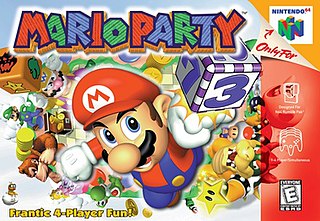
Mario Party is a party video game developed by Hudson Soft and published by Nintendo for the Nintendo 64. It was released in Japan on December 18, 1998, in North America on February 8, 1999, and in Europe and Australia on March 9, 1999. The game was targeted at a young audience. Mario creator Shigeru Miyamoto served as development supervisor. It received mostly positive critical reviews for its multiplayer mode, concept, and music; disapproval of its slow pacing; and mixed reviews of its graphics. It is the first installment in the Mario Party series, followed by Mario Party 2 in 1999 for Nintendo 64. The game received its first official re-release on the Nintendo Switch Online + Expansion Pack on November 2, 2022.

Mario Party 4 is a 2002 party video game developed by Hudson Soft and published by Nintendo for the GameCube. The game is the fourth installment in the Mario Party series and is the first game in the series to be released for the GameCube. Like the previous games in the series, it features eight playable characters: Mario, Luigi, Princess Peach, Yoshi, Wario, Donkey Kong, Princess Daisy, and Waluigi from the Mario franchise, who can be directed as characters on 6 themed game boards. The objective is to earn as many stars as possible, which are obtained by purchase from a single predefined space on the game board. Each character's movement is determined by a roll of a die, with a roll from each player forming a single turn. Each turn is followed by a minigame in which characters compete for coins they can use to purchase items and stars.

Mario Party 2 is a 1999 party video game developed by Hudson Soft and published by Nintendo for the Nintendo 64. The second game in the Mario Party series, it was released in Japan in December 1999 and worldwide in 2000. The game received mostly positive reviews, who praised the improvements they made to the original, the multiplayer and minigames, but criticized the lack of originality, while graphics received a better but otherwise mixed response.

Kensington is an abstract strategy board game devised by Brian Taylor and Peter Forbes in 1979, named after London's Kensington Gardens, which contains the mosaic upon which the gameboard is patterned. It is played on a geometrical board based on the rhombitrihexagonal tiling pattern. The objective of the game is to capture a hexagon by occupying the six surrounding vertices. The game maintains an elegant simplicity while still allowing for astonishingly complex strategy. The placing and movement of tokens have been compared to nine men's morris.

Sorry! is a board game that is based on the ancient Indian cross and circle game Pachisi. Players move their three or four pieces around the board, attempting to get all of their pieces "home" before any other player. Originally manufactured by W.H. Storey & Co in England and now by Hasbro, Sorry! is marketed for two to four players, ages 6 and up. The game title comes from the many ways in which a player can negate the progress of another, while issuing an apologetic "Sorry!"
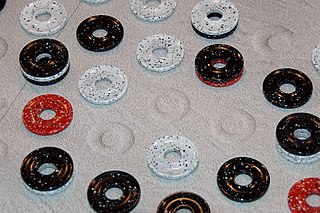
DVONN is a two-player strategy board game in which the objective is to accumulate pieces in stacks. It was released in 2001 by Kris Burm as the fourth game in the GIPF Project. DVONN won the 2002 International Gamers Award and the Games magazine Game of the Year Award in 2003.

EA Sports is a division of Electronic Arts that develops and publishes sports video games. Formerly a marketing gimmick of Electronic Arts, in which they imitated real-life sports networks by calling themselves the "EA Sports Network" (EASN) with pictures or endorsements. It soon grew up to become a sub-label on its own, releasing game series such as EA Sports FC, PGA Tour, NHL, NBA Live, and Madden NFL.

Mario Party is a party video game series featuring characters from the Mario franchise in which up to four local players or computer-controlled characters compete in a board game interspersed with minigames. The games are currently developed by NDcube and published by Nintendo, being previously developed by Hudson Soft. The series is known for its party game elements, including the often unpredictable multiplayer modes that allow play with up to four, and sometimes eight, human players or CPUs.

TAMSK is a two-player board game designed by Kris Burm. It was originally published in 1998 as the second game in the GIPF Project series of abstract strategy games, although it was later dropped from the series in favor of TZAAR. Players move sand hourglass timers and drop plastic rings around spaces on a hexagonal board in an attempt to limit their opponent's moves. Each player starts the game with 32 rings, and the player with the fewest remaining rings at the end of the game is the winner. The game is unique among the GIPF Project games in having time as a central game component, and the manner in which time is used is possibly unique among board games in general.

YINSH is an abstract strategy board game by game designer Kris Burm. It is the fifth game to be released in the GIPF Project. At the time of its release in 2003, Burm stated that he intended it to be considered as the sixth and last game of the project, and that the game which he had not yet released, PÜNCT, would be logically the fifth game. However, the series was later expanded to seven games with the release of LYNGK.
Star is a two-player abstract strategy board game developed by Craige Schensted. It was first published in the September 1983 issue of Games magazine. It is a connection game similar to Hex, Y, Havannah, and TwixT. Unlike these games, however, the result is based on a player having a higher final score rather than achieving a specific goal. He has since developed a slightly more complicated version called *Star with better balance between edge and center moves, writing "*Star is what those other games wanted to be."
The 5th National Hockey League All-Star Game took place at Maple Leaf Gardens, home of the Toronto Maple Leafs, on October 9, 1951. Two teams of all-star players played to a 2–2 tie.

Starsweep is a puzzle game by Japanese developer Axela, released in 1997 in Japanese arcades and for the PlayStation, and in 1998 for the Game Boy.
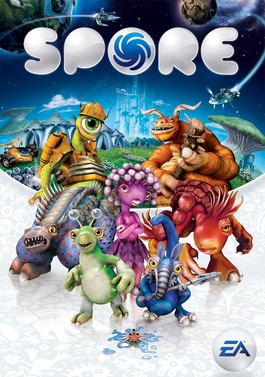
Spore is a 2008 life simulation real-time strategy god game developed by Maxis and published by Electronic Arts for Microsoft Windows and Mac OS X. Designed by Will Wright, it covers many genres including action, real-time strategy, and role-playing games. Spore allows a player to control the development of a species from its beginnings as a microscopic organism, through development as an intelligent and social creature, to interstellar exploration as a spacefaring culture. It has drawn wide attention for its massive scope, and its use of open-ended gameplay and procedural generation. Throughout each stage, players are able to use various creators to produce content for their games. These are then automatically uploaded to the online Sporepedia and are accessible by other players for download.
A connection game is a type of abstract strategy game in which players attempt to complete a specific type of connection with their pieces. This could involve forming a path between two or more endpoints, completing a closed loop, or connecting all of one's pieces so they are adjacent to each other. Connection games typically have simple rules, but complex strategies. They have minimal components and may be played as board games, computer games, or even paper-and-pencil games.

Orbient, known in Japan as Orbital, is a puzzle video game developed by Skip Ltd. and published by Nintendo for the Wii's WiiWare digital distribution service. It is one of twelve games in the Art Style series of video games available for WiiWare and DSiWare. It is a remake of a Japan-only Game Boy Advance video game titled Orbital, released for the bit Generations series of video games.
The 2009–10 Iraqi Premier League was the 36th edition of the competition. It was initially set to start in October 2009, but was later rescheduled for December as a 36-team league. The season saw Duhok crowned as champions for the first time.

Ask Me Another is an hour-long radio puzzle game show that was produced by WNYC and National Public Radio. It was hosted by Canadian American comedian Ophira Eisenberg and featured as its "in-house musician" or "one-man house band" independent rock musician Jonathan Coulton. Episodes of the show were usually recorded at The Bell House in Brooklyn, New York, however the show did go to various states across the country and recorded one or more episodes from those locations. The show was produced by WNYC Studios. During the COVID-19 pandemic in the United States, the show continued taping episodes from the homes of the participants, without a studio audience.
